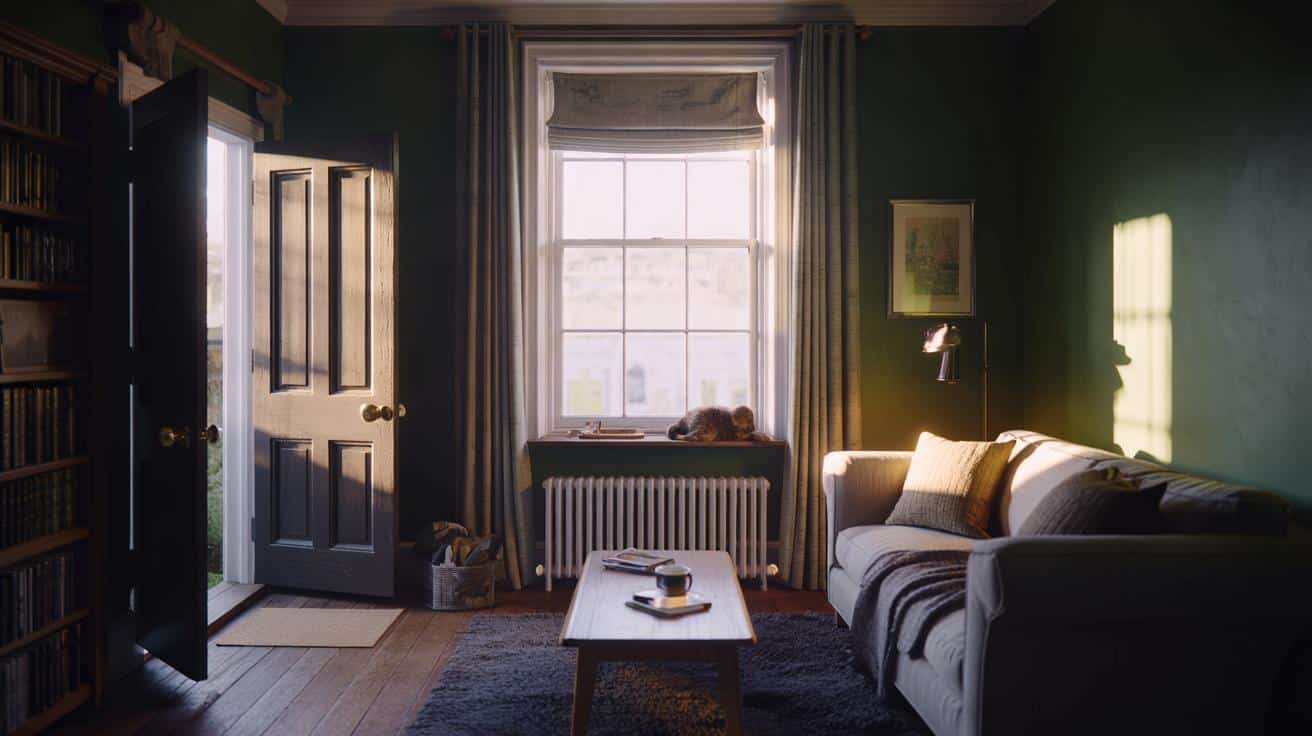You can throw money at the thermostat, or you can tweak the way your space is dressed and laid out. The second route is quieter, cheaper, and oddly satisfying.
The morning starts with a sigh from the kettle and a pale sun fingering the edge of a sash window. You pull on a jumper, pad across boards that remember every winter since 1903, and place a mug near the bit of carpet that always seems warmer. The cat has claimed the radiator’s top as if it’s a spa. A square of light creeps over a dark rug and the air changes, almost like the room is breathing. The neighbours’ chimneys sketch thin lines against a crisp sky. You close the hallway door and the sitting room feels less exposed, more itself. *Something small, almost invisible, is working in your favour.* Then the penny drops.
Why warmth vanishes fast in UK homes
British houses lose heat fast because they’re charmingly leaky. Old sash windows, suspended timber floors, uninsulated loft hatches and gappy door frames team up to whisk warmth away like a backstage crew. You feel it as a draught across your ankles or a chill pooling on the stairs. We’ve all had that moment when you step from a snug room to the landing and it hits you like a mild sea breeze from 1898. Character, yes. Cosiness, not so much.
On paper, it’s stark. Studies regularly show UK homes shed heat far quicker than homes in colder countries, thanks to thin walls and draught pathways. Walk a typical terrace at dusk and you’ll see curtains floating as if the house is exhaling. A friend in Leeds taped a strip of tissue to their window frame; it fluttered all evening. Heat wasn’t just escaping, it was sprinting down the road in a woolly hat.
Blame the stack effect: warm air rises, escapes through the loft or upstairs leaks, and sucks cold air in at ground level to replace it. Add cold surfaces that radiate a chill — bare plaster on an external wall, single-glazed panes — and your body reads the room as cooler than the thermostat number. That’s why design tricks matter. You slow the air movement, warm the surfaces you touch and see, and guide the little heat you do have to the places you live in.
Design moves that trap heat without cranking the thermostat
Start with the three biggest leaks you can influence today: windows, floors, and internal doors. Dress windows like they’re wearing a winter coat — thick, lined curtains that touch the floor, hung high and wide, with a snug header or pelmet that blocks the convective loop behind the fabric. Add stick-on insulating film to single glazing, and close blinds and curtains at dusk to lock in daytime gain. Lay rugs over bare boards, especially near external walls and in rooms above a ventilated void. Then zone your home with doors: keep the warm rooms enclosed, especially the stairwell. That single gesture changes everything.
Next, work with radiators, not against them. Slide reflective foil behind rads on external walls, leave 10–15 cm breathing room in front, and add a shallow shelf above to throw warmth into the room rather than up the curtains. Don’t park a sofa right across a radiator — it’s like hanging a coat on a heater and hoping for the best. Bleed radiators at the start of the season and set TRVs to give each room its own logic. Let’s be honest: no one does that every single day. **Do it once, then let the house carry the habit.**
Then tackle the sneaky gaps. Fit a brush to the letterbox, a flap over the keyhole, and a simple draught excluder at the foot of external doors. Pop a chimney balloon in an unused fireplace, and seal the loft hatch with foam strip plus an insulated cover. Bookcases on external walls add a layer of still air; heavy textiles or a tapestry behind a sofa can subtly warm a cold wall. **Small layers, stacked with intention, turn into steady comfort.**
“Warmth isn’t just a number on a thermostat. It’s air that’s still, surfaces that don’t feel icy, and light that cues your body to relax.”
- Open south-facing blinds in the morning, close everything before dusk.
- Hang a thick door curtain on the hall-to-lounge doorway in a terrace.
- Place a dark, dense rug where winter sun lands to soak and release heat.
- Use a folding screen to cordon off a draughty bay on cold nights.
- Put warm seating away from external corners and window glass.
What the data means for your layout and look
Thermal gain starts with light. Sunlight hitting a dark, dense surface acts like a free, slow radiator. Track where winter sun falls in your home for a week. Then move a rug, a table, even a stack of books into that spot and keep the path clear. Paint matters too: deeper, matte colours on external walls feel visually warmer and can reduce the sensation of radiant chill. It’s not magic. It’s psychology nudging physics along.
Classic UK features can be allies with a few tweaks. Sash windows love a snug secondary pane: slim, clip-in acrylic panels or a well-fitted secondary glazed unit can quiet the street and the cold. A lined Roman blind paired with floor-length drapes seals the reveal. In a Victorian terrace, a thick portière over the hall door stops stairwell suction. On suspended floors, dense underlay under rugs or a roll of wool felt along skirting gaps returns warmth to your feet. **Close the doors. Heat the person, not the house.**
Furniture placement sets the microclimate. Keep seating off external walls by a hand’s breadth or two so air can warm as it circulates. Swap a metal-legged coffee table for wood, which doesn’t read as cold to the touch. If a radiator sits beneath a window, choose curtains that stop just above the sill or add that neat shelf to kick heat forward. Avoid tall units flanking an uninsulated external corner; they trap cold and create a downdraught you’ll feel on your neck. Dress your sofa with wool throws. Warmth is sometimes a texture before it’s a temperature.
Daily habits that don’t feel like chores
Make a dusk ritual that works on autopilot. Open curtains to chase any winter sun; close them all before the light slips, starting with the biggest panes. Shut the door to the stairwell. Click TRVs in the rooms you’ll actually use this evening. Pop a draught excluder back against the front door. It’s a one-minute circuit with outsized results.
Cut the cold at the source when you can. Fit a brush strip to the bottom of the front door and a proper seal around the frame. Add a keyhole cover that flips closed on its own. If you’ve got an unused fireplace, install a balloon or a chimney sheep and hang a discreet note on the mantel so you remember it’s there. Don’t forget the loft hatch; an insulated cover stops warm air vanishing upstairs where you don’t live. Be kind to yourself if you miss a day. Warmth is a routine, not a performance.
There’s also the look and feel that makes warmth stick. Swap thin curtains for interlined ones in the rooms you use at night. Layer a runner along a cold hallway. Choose cushions with wool or bouclé that invite you to stay. Your body relaxes faster when the room looks soft, and that makes the heat you have go further.
“Design can’t change the weather, but it can change how your home holds on to comfort.”
- Thermal curtain linings cost less than new drapes and change the game.
- Radiator foil is cheap, invisible in use, and pays back fast on external walls.
- Self-adhesive window film adds a still air layer to single glazing.
- Door brushes, letterbox plates, and keyhole covers slam shut easy leaks.
- Secondary glazing kits for sash windows are a weekend job, not a rebuild.
Leave space for warmth to happen
Homes warm up in layers — light, still air, gentle surfaces, the right boundaries. When you tweak layout and textiles first, the boiler becomes a background actor, not the star. The pleasure is in noticing the small wins: a hallway that no longer howls, a seat that stays comfy at 18°C, a floor that doesn’t bully your ankles. Share what works at your place and steal what works at your friend’s. The best winter design isn’t glossy. It’s the quiet rigging that lets your rooms hold a mood. And it starts tonight, at dusk, with a pair of curtains and a closed door.
| Key points | Detail | Reader Interest |
|---|---|---|
| Dress windows like winter coats | Lined curtains, pelmets, secondary glazing, dusk routine | Fast comfort boost with low spend |
| Control air, not just heat | Zone with doors, stop stack effect, seal obvious leaks | Warmer rooms without higher bills |
| Use surfaces and layout | Dark rugs in sun, radiator shelves, move sofas off rads | Design-led fixes that feel satisfying |
FAQ :
- What’s the quickest win for a cold living room?Close the door, add a thick rug, and shut lined curtains at dusk. You’ll feel it within minutes.
- Do radiator reflectors really work?On external walls, yes. They bounce heat back into the room and cost pennies.
- Are pelmets old-fashioned or effective?Both. A simple, modern pelmet stops warm air vanishing behind curtains.
- Will a shelf above my radiator help?It nudges warm air into the room and protects curtains. Keep it shallow.
- How do I stop draughts from the fireplace?Use a chimney balloon or wool “sheep” in unused flues, and tag it so you remember it’s there.








